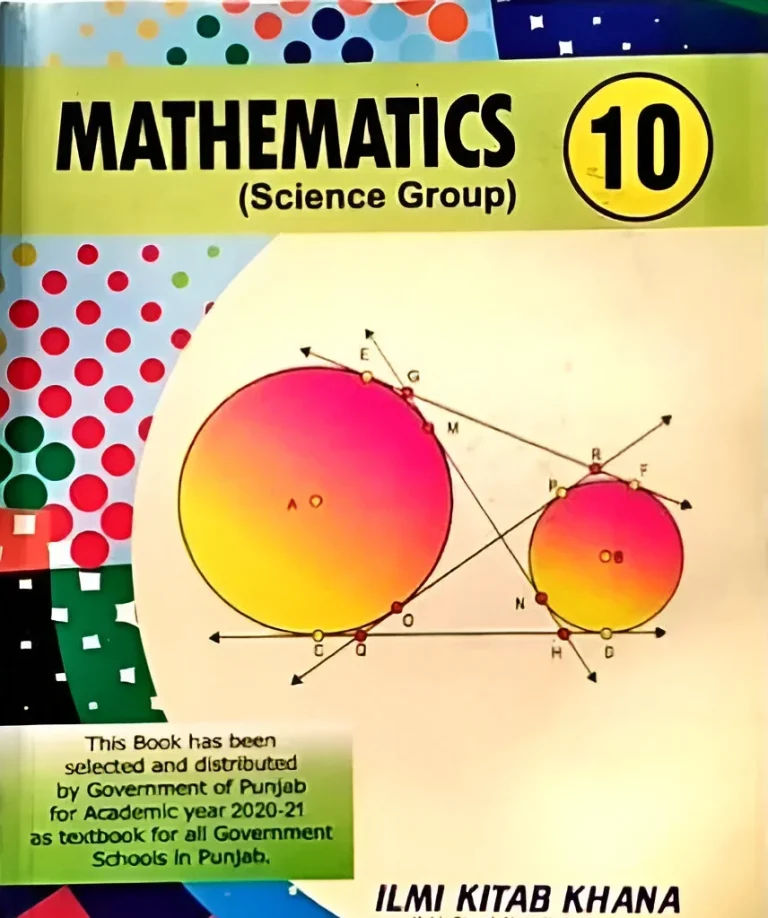Download 11th Class Math New Book 2025 PDF
The 11th class math new book 2025 has been released under the Punjab Curriculum and Textbook Board (PCTB), now officially known as the Punjab Education, Curriculum, Training and Assessment Authority (PECTAA).
This new textbook follows the Revised National Curriculum of Pakistan 2023 and is now the official course for FSc and ICS Part 1 (HSSC-I) students across Punjab.
In this article, you can:
📥 Download the official PDF from the PCTB website
🧠 Get study tips and FAQs to prepare effectively
🧮 Understand the new syllabus changes
📚 Read short unit-wise explanations
📥 Download New 11th Class Math Book PDF

Click above button to download the text book from official PCTB e-Books portal as notesofmath.com does not host or distributes any copyright material.
Key Curriculum Changes in the 2025 Edition
The 2025 syllabus has been redesigned to shift from repetitive algebraic exercises to conceptual mathematics. It prepares students for higher studies in engineering, computer science, and physics by focusing on logic, visualization, and pre-calculus skills.
Here’s an overview of the key changes:
| Category | Updated or New Topics | Purpose |
|---|---|---|
| Calculus Foundation | Limits, Continuity, Differentiation | Introduces concepts of change and motion for future calculus. |
| 3D Geometry | Vectors in Space | Helps visualize and solve problems in physics and mechanics. |
| Advanced Algebra | Polynomial Division, Quadratic Functions | Develops function analysis and graph interpretation skills. |
| Streamlined Content | Sets, Groups, Inverse Trig, Probability (Removed/Merged) | Reduces load; focuses syllabus on practical and essential areas. |
📚 Comprehensive Unit-Wise Study Guide
Unit 1: Complex Numbers – Extending the Number System

This unit introduces students to numbers that go beyond real numbers — the complex numbers. You’ll learn how to represent and simplify expressions involving the imaginary unit \(i=−1i = \sqrt{-1}i=−1\). Topics include the algebra of complex numbers, their graphical representation, modulus and argument, conjugates, and polar form. This concept is essential in advanced algebra and electrical engineering.
Unit 2: Functions and Graphs – Visualizing Relationships
Functions are mathematical rules that assign outputs to inputs. This unit explains different types of functions including linear, quadratic, absolute value, and step functions. You’ll also learn how to draw and interpret graphs, determine domains and ranges, and analyze real-life relationships. A strong understanding here is crucial for calculus and economics.
Unit 3: Theory of Quadratic Functions – Beyond Simple Equations
This chapter goes deeper into quadratic expressions. Instead of just solving quadratic equations, you’ll learn how to analyze their graphs — vertex, axis of symmetry, direction of opening, and maximum/minimum values. Real-world modeling problems are included to help students understand how quadratics work in motion, profit, and projectile questions.
Unit 4: Matrices and Determinants – Tools for Organizing Data
This unit introduces matrices, which are rectangular arrays of numbers used in fields like computer science, physics, and economics. You’ll learn how to perform operations like addition, multiplication, finding inverses, and solving systems of equations using matrices and determinants. This unit builds critical thinking and structured problem-solving skills.
Unit 5: Partial Fractions – Simplifying Complex Rational Expressions
Partial fractions help break complicated algebraic fractions into simpler components. This technique is vital in integration (in calculus), control systems, and signal processing. You’ll learn how to decompose rational expressions into simpler fractions and solve them easily. Practice in this chapter will prepare you for future work in calculus and physics.
Unit 6: Sequences and Series – Recognizing Mathematical Patterns
In this chapter, you’ll explore patterns in numbers, both finite and infinite. You’ll study arithmetic and geometric sequences, series, and how to find general terms and sums. Applications in finance (like interest) and population models are also included. This unit is excellent for developing logical thinking and mathematical modeling skills.
Unit 7: Permutations and Combinations – Mastering Counting Techniques
This unit focuses on counting techniques used in probability and decision-making. Permutations involve arrangements, while combinations focus on selections. You’ll solve problems involving factorials, repetition, and real-life scenarios like seating arrangements or team selection. These skills are also used in probability, computer science, and cryptography.
Unit 8: Mathematical Induction and Binomial Theorem – Proof and Expansion
Here, you’ll learn how to prove mathematical statements using mathematical induction, a technique used to prove results for an infinite set of cases. You’ll also study the binomial theorem for expanding expressions like (a+b)n(a + b)^n(a+b)n, and find coefficients using binomial expansions. These ideas appear often in higher mathematics and physics.
Unit 9: Division of Polynomials – Breaking Down Algebraic Expressions
This unit explains how to divide one polynomial by another using long division and synthetic division. You’ll learn how to find quotients and remainders, as well as applications of the remainder and factor theorems. This chapter is essential for simplifying expressions before applying limits, differentiation, or solving equations.
Unit 10: Trigonometric Identities – Connecting Angles and Ratios
You’ll study essential identities like Pythagorean, reciprocal, and cofunction identities, and learn to prove and simplify complex expressions using them. Mastering identities helps in solving trigonometric equations and modeling periodic phenomena such as waves, light, and sound.
Unit 11: Trigonometric Functions and Their Graphs – Visual Patterns in Rotation
This chapter introduces the graphs of sine, cosine, tangent, and their inverse functions. You’ll analyze amplitude, frequency, and phase shift — important concepts in physics, engineering, and signal analysis. By visualizing these graphs, students understand how angles relate to movement and oscillation.
Unit 12: Limit and Continuity – Approaching Calculus
Limits form the basis of calculus. This unit teaches how to evaluate what value a function approaches as the input gets closer to a point. You’ll explore one-sided limits, infinite limits, and conditions for continuity. It develops precision and deep understanding needed for calculus and physics.
Unit 13: Differentiation – Measuring Change
This is your introduction to calculus. Differentiation allows you to compute the rate of change of functions. You’ll learn basic derivative rules, application in real-life problems like velocity and optimization, and sketch graphs using slope information. This chapter is essential for careers in engineering, data science, and economics.
Unit 14: Vectors in Space – Direction and Magnitude in 3D
Vectors represent quantities with both magnitude and direction. You’ll study 2D and 3D vectors, vector addition, scalar and dot product, and applications in physics and geometry. This topic builds spatial reasoning skills and prepares you for mechanics and higher-level mathematics.
🗓️ Study Planning with the New 2025 Math Book
Use the following monthly breakdown to complete the 2025 math syllabus efficiently:
🧪 Exam Tips for the New 11th Class Math Book 2025
- Focus on graph interpretation and functions
- Solve full-length application questions
- Practice using the updated examples from the 2025 edition
- Use flashcards to remember identities from the new trigonometry units
🎯 Transitioning from 10th to 11th: What’s New?
Coming from Class 10? Expect a major shift in:
- Graph-based questions
- Proofs and logic-based problems
- Pre-calculus foundations like limits and derivatives
The new math book 2025 for class 11 Punjab board is designed to help you bridge this gap effectively.
📈 Preparing for Class 12
Key skills from this new 11th class math book PDF will continue in Class 12:
- Trigonometric transformations
- Polynomial analysis
- Calculus basics
The book is structured to make your 2nd-year transition smoother.
😟 Common Student Challenges – And Fixes
- Limits & Vectors too abstract? Use GeoGebra.
- Forgetting identities? Flashcards + spaced repetition.
- Struggling with graphs? Practice transformations daily.
🛡️ Legal and Content Disclaimer
This website respects all copyright and intellectual property rights of the Punjab Education, Curriculum, Training and Assessment Authority (PECTAA).
Notes of Math does not host or distribute the official textbook PDF; the provided link leads only to the official PCTB portal for educational access.
All content on this page is original and written to guide students about the syllabus, structure, and learning approach of the 2025 book.
📚 Further Resources
- 📘 Punjab Curriculum and Textbook Board (PCTB) – Official Website – For verified and up-to-date textbooks.
- 📗 NotesOfMath.com – 10th Class Math Book PDF – Download the latest 10th class book with chapter summaries.
- 📕 NotesOfMath.com – 9th Class Math Book PDF – Access the new syllabus math book for Class 9.
- 🎥 Khan Academy – FSc Math Concepts – Free concept lectures in calculus, functions, and more.
- 🧮 Desmos Graphing Calculator – Practice graphing functions visually.
- 📊 GeoGebra Math Tools – Explore vectors, calculus, and algebra visually.
✅ Conclusion: Your First Step Toward Math Success
The 11th class math new book 2025 PDF Punjab board version is more than just a book — it’s a roadmap to success in FSc, competitive exams, and higher education. If you haven’t already, check out the 10th class math book and 9th class math book as well — both fully updated for the new syllabus.
📘 Download the book, follow the study plan, and keep visiting NotesOfMath.com for solved notes, practice questions, and study resources that make learning easier and smarter.
❓ FAQs
Q1: What is the latest Class 11 Math book in 2025?
The latest book is the 2025 PCTB/PECTAA edition, aligned with the Revised National Curriculum of Pakistan (2023).
Q2: Where can I download the official PDF?
You can download it from the official PCTB e-Books portal: https://pctb.punjab.gov.pk/E-Books.
Q3: Is this book for both FSc and ICS students?
Yes. The same Class 11 Math textbook is used for both FSc (Pre-Engineering, Pre-Medical) and ICS Part 1 students.
Q4: What are the main changes in 2025?
The inclusion of Calculus and 3D Vectors, while some abstract topics like Sets and Groups are simplified or merged.
Q5: How can I prepare effectively?
Start with easy exercises, then move to conceptual ones. Use diagrams and online tools to understand graphs and vectors visually.


